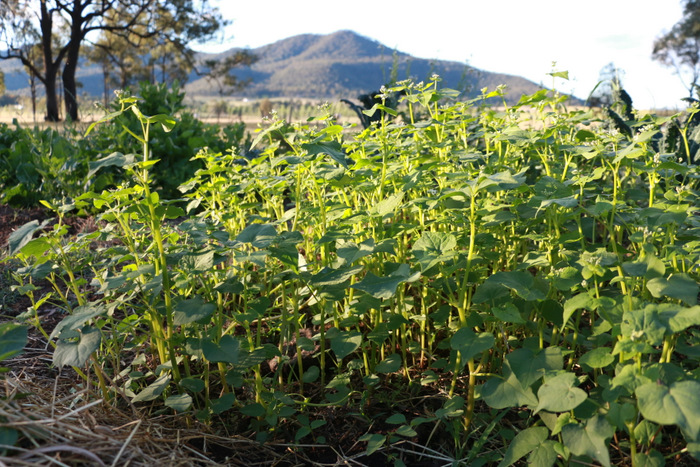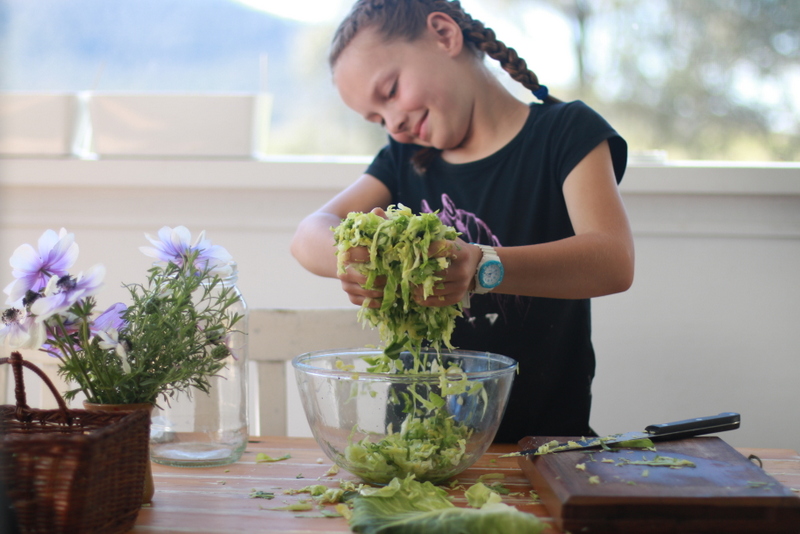An easy and frugal way to improve your garden soil is to grow green manure. Green manures are plants grown specifically to be composted back into the soil. They build organic matter and increase the availability of nitrogen and other nutrients. For me, their main appeal is they suit my lazy gardening style. Sowing a handful of seed, and turning the crop into the soil a month later, is far easier than bringing in barrow-loads of compost.
Green manures are a great way to help prepare your garden for a hot and dry summer.
They increase the amount of organic matter or humus in the soil, which in turn increases moisture retention.
Green manure crops can also send roots deep into the soil, opening it up and helping later crops obtain water from deeper.
My spring garden includes a patch of buckwheat and a patch of cowpea and millet combined.
The buckwheat was sown primarily to quickly build organic matter in a new extension to my garden. As a bonus, I’m using the leaves as a vegetable and the flowers will attract pollinators into my garden.
Pairing millet and cowpea is an example of combining a grass with a legume – a common approach when growing green manures. Millet is a fast-growing grass and adds bulk organic material. Cowpea is a legume and increases nitrogen availability in the soil. Its roots form an association with soil-borne bacteria that can grab nitrogen from the atmosphere and turn into a form that can be used by the next crop.
Other warm-season green manures that can be sown now include mung bean and soybean.
Come early autumn, I’ll sow some cool-season green manures. My favourites include broad beans, mustard, vetch, rye and oats. I’m also going to try lupins for the first time. I love the idea of having a patch of this beautiful tall blue flowering plant.
To sow green manure seeds, cast them by the handful on to freshly cultivated ground.
Cover seeds lightly with a thin layer of compost or use a rake to move the soil around until all the seeds are covered.
Harvest timing is important for green manures.
Harvest just as plants start flowering and before they set seed. Once a plant produces seed, it directs all its energy to the growing seed. Given it is the leafy green growth that will help build your soil, you want to harvest when the plants are still putting most of their energy into the leaves.
Letting a green manure go to seed also risks it becoming a weed in your garden. I regret letting amaranth go to seed in my garden. It’s a useful green manure, but I’m now forever weeding it out.
There’s a range of ways you can harvest your green manure.
You can pull it out or slash it. You can leave it to compost on the soil surface, cover it with a layer of mulch, or dig it into the soil.
One of the main limitations of green manure is that you need to wait until it has broken down before sowing your next crop. This can take one to two months, depending on soil temperature and whether you bury your green manure. You can speed up the composting process by covering your green manure in mulch or digging it in.
Better than buying by the bag.
Growing your own green manure is far more environmentally friendly than buying compost or fertiliser by the bag. Growing your own manure is the ultimate in DIY gardening.
Originally published in the Newcastle Herald Monday 20th October 2014.



